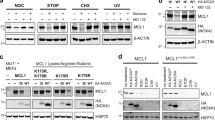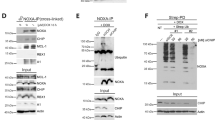Abstract
For a long time, as the most prominent subnuclear structure, nucleolus has been recognized as a main site where rRNA processing and ribosomal subunit assemblies take place. It has not been until recently that additional functions of nucleolus have begun to be proposed. In this study, we for the first time demonstrate that Survivin-deltaEx3, a novel functionally splice variant of Survivin localizes in the nucleoli where it degrades rapidly through ubiquitin–proteosome pathway. Several lines of evidences provided in this report support this finding (i) a novel nucleolar localization sequence (NoLS, MQRKPTIRRKNLRLRRK) and a novel degradation signal (aa92–aa137) within Survivin-deltaEx3 were identified (ii) proteasome inhibitors MG132 or ALLN greatly inhibits degradation of Survivin-deltaEx3 and polyubiquitination of Survivin-deltaEx3 was detected (iii) heterologous proteins such as TAT-PTD or p14ARF, when fused to this putative degradation signal, result in a significant degradation within the nucleolus. In addition, the nucleolar localization and degradation of Survivin-deltaEx3 appear to be required for its antiapoptotic function, since neither NoLS-deleted nor degradation signal-deleted Survivin-deltaEx3 retains protective effect against Doxorubicin-induced apoptosis. Thus, our results have provided evidences to suggest that besides cytosol, nucleus, endoplsmic reticulum (ER) or lysosomes, nucleolus may also operate important protein degradation pathway, which has been overlooked previously.
This is a preview of subscription content, access via your institution
Access options
Subscribe to this journal
Receive 50 print issues and online access
$259.00 per year
only $5.18 per issue
Buy this article
- Purchase on Springer Link
- Instant access to full article PDF
Prices may be subject to local taxes which are calculated during checkout






Similar content being viewed by others
References
Altieri DC . (2003). Nat. Rev. Cancer., 3, 46–54.
Ambrosini G, Adida C and Altieri DC . (1997). Nat. Med., 3, 917–921.
Antoine M, Reimers K, Dickson C and Kiefer P . (1997). J. Biol. Chem., 272, 29475–29481.
Arabi A, Rustum C, Hallberg E and Wright AP . (2003). J. Cell Sci., 116, 1707–1717.
Bonifacino JS and Weissman AM . (1998). Annu. Rev. Cell Dev. Biol., 14, 19–57.
Carmo-Fonseca M, Mendes-Soares L and Campos I . (2000). Nat. Cell Biol., 2, E107–E112.
Creancier L, Prats H, Zanibellato C and Amalric FB . (1993). Mol. Biol. Cell, 4, 1239–1250.
Everett RD, Meredith M, Orr A, Cross A, Kathoria M and Parkinson J . (1997). EMBO J., 16, 566–577.
Galcheva-Gargova Z, Gangwani L, Konstantinov KN, Mikrut M, Theroux SJ, Enoch T and Davis RJ . (1998). Mol. Biol. Cell, 9, 2963–2971.
Itahana K, Bhat KP, Jin A, Itahana Y, Hawke D, Kobayashi R and Zhang Y . (2003). Mol. Cell, 12, 1151–1164.
Kaffman A and O'Shea EK . (1999). Annu. Rev. Cell Dev. Biol., 15, 291–339.
Krieg A, Mahotka C, Krieg T, Grabsch H, Muller W, Takeno S, Suschek CV, Heydthausen M, Gabbert HE and Gerharz CD . (2002). Br. J. Cancer, 86, 737–743.
Laney JD and Hochstrasser M . (1999). Cell, 97, 427–430.
Latonen L, Kurki S, Pitkanen K and Laiho M . (2003). Cell Signal, 15, 95–102.
Lenk U and Sommer T . (2000). J. Biol. Chem., 275, 39403–39410.
Li F . (2003). J. Cell Physiol., 197, 8–29.
Li F, Ambrosini G, Chu EY, Plescia J, Tognin S, Marchisio PC and Altieri DC . (1998a). Nature, 396, 580–584.
Li X, Zhao X, Fang Y, Jiang X, Duong T, Fan C, Huang CC and Kain SR . (1998b). J. Biol. Chem., 273, 34970–34975.
Lindsten K, Menendez-Benito V, Masucci MG and Dantuma NP . (2003). Nat. Biotechnol., 21, 897–902.
Lohrum MA, Ashcroft M, Kubbutat MH and Vousden KH . (2000). Nat. Cell Biol., 2, 179–181.
Mahotka C, Wenzel M, Springer E, Gabbert HE and Gerharz CD . (1999). Cancer Res., 59, 6097–6102.
Mattsson K, Pokrovskaja K, Kiss C, Klein G and Szekely L . (2001). Proc. Natl. Acad. Sci. USA, 98, 1012–1017.
Olson MO, Dundr M and Szebeni A . (2000). Trends Cell Biol., 10, 189–196.
Olson MO, Hingorani K and Szebeni A . (2002). Int. Rev. Cytol., 219, 199–266.
Pederson T . (1998a). J. Cell Biol., 143, 279–281.
Pederson T . (1998b). Nucleic Acids Res., 26, 3871–3876.
Pokrovskaja K, Mattsson K, Kashuba E, Klein G and Szekely L . (2001). J. Gen. Virol., 82, 345–358.
Rizos H, Darmanian AP, Mann GJ and Kefford RF . (2000). Oncogene, 19, 2978–2985.
Rudin CM and Thompson CB . (1997). Annu. Rev. Med., 48, 267–281.
Satyamoorthy K, Bogenrieder T and Herlyn M . (2001). Trends Mol. Med., 7, 191–194.
Schmidt-Zachmann MS and Nigg EA . (1993). J. Cell Sci., 105, 799–806.
Skoufias DA, Mollinari C, Lacroix FB and Margolis RL . (2000). J. Cell Biol., 151, 1575–1582.
Sommer T and Wolf DH . (1997). FASEB J., 11, 1227–1233.
Song Z, Liu S, He H, Naser H, Wang Y, Feng S and Wu M . (2004). Mol. Biol. Cell, 15, 1287–1296.
Song Z, Yao X and Wu M . (2003). J. Biol. Chem., 278, 23130–23140.
Stauber RH and Pavlakis GN . (1998). Virology, 252, 126–136.
Stegh AH, Schickling O, Ehret A, Scaffidi C, Peterhansel C, Hofmann TG, Grummt I, Krammer PH and Peter ME . (1998). EMBO J., 17, 5974–5986.
Varshavsky A . (1996). Proc. Natl. Acad. Sci. USA, 93, 12142–12149.
Vives E, Brodin P and Lebleu B . (1997). J. Biol. Chem., 272, 16010–16017.
Wang HW, Sharp TV, Koumi A, Koentges G and Boshoff C . (2002). EMBO J., 21, 2602–2615.
Wurm T, Chen H, Hodgson T, Britton P, Brooks G and Hiscox JA . (2001). J. Virol., 75, 9345–9356.
Yamada Y, Kuroiwa T, Nakagawa T, Kajimoto Y, Dohi T, Azuma H, Tsuji M, Kami K and Miyatake S . (2003). J. Neurosurg., 99, 738–745.
Zhang Y and Xiong Y . (1999). Mol. Cell, 3, 579–591.
Zhao J, Tenev T, Martins LM, Downward J and Lemoine NR . (2000). J. Cell Sci., 113, 4363–4371.
Acknowledgements
We thank Dr Lydie Da Costa (Laboratoire d'Hematologie, Hopital de Bicetre, Le Kremlin Bicetre, France), and Dr John C Reed (The Burnham Institute, La Jolla, CA 92037, USA) for providing plasmids used in this study, we also thank Ms Wang Yi for her excellent technical help. This research was supported by a 973 grant (2002CB713702) from Ministry of Science and Technology of China, the Key Project Fund (KSCX2-2-01-004) from the Chinese Academy of Sciences, grants from the National Natural Science Foundation of China (90208027 and 30121001) and a grant from School of Biological Sciences, Nanyang Technological University to MW (SBS/SUG/22/04), Singapore.
Author information
Authors and Affiliations
Corresponding author
Rights and permissions
About this article
Cite this article
Song, Z., Wu, M. Identification of a novel nucleolar localization signal and a degradation signal in Survivin-deltaEx3: a potential link between nucleolus and protein degradation. Oncogene 24, 2723–2734 (2005). https://doi.org/10.1038/sj.onc.1208097
Received:
Revised:
Accepted:
Published:
Issue Date:
DOI: https://doi.org/10.1038/sj.onc.1208097
Keywords
This article is cited by
-
Mechanisms of gene regulation by histone degradation in adaptation of yeast: an overview of recent advances
Archives of Microbiology (2022)
-
Identification of FOXM1 as a therapeutic target in B-cell lineage acute lymphoblastic leukaemia
Nature Communications (2015)
-
Nucleolar localization and identification of nuclear/nucleolar localization signals of the calmodulin-binding protein nucleomorphin during growth and mitosis in Dictyostelium
Histochemistry and Cell Biology (2011)
-
Identification and characterization of a novel gene differentially expressed in zebrafish cross-subfamily cloned embryos
BMC Developmental Biology (2008)
-
The clinical significance of splice variants and subcellular localisation of survivin in non-small cell lung cancers
British Journal of Cancer (2008)



